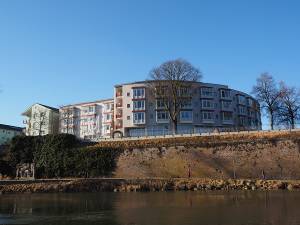For anyone over the age of 62 living on Social Security low income senior housing is probably the only option when looking for a place to live.
Low Income Senior Housing Can Be Very Nice
Despite the images of dreary, run-down, bug infested apartments most low income senior housing is actually quite nice and undergo regular inspections.
Many residences are apartment buildings with activity centers and planned events such as trips to the local stores and some have meal services available as well. In fact, you have probably seen a group of seniors getting out of their shuttle bus at the grocery store.
Some subsidized senior housing will also have staff that can assist a senior that has mobility issues and some units are designed with this in mind with step in showers instead of tubs, etc.
Yes, there are some poorly maintained units in large cities but for the most part the subsidized senior housing is clean, safe and a fun place to live.
As I stated earlier if you or your spouse is at least 62 you are eligible for housing assistance as long as you do not have any children living with you.
The next step is to check your income which is calculated by subtracting any approved medical expenses from what you get each month and this adjusted gross income is compared to a table that the HUD department maintains.
This table has median income levels for every state and county and your income must be less than the 50% mark which is considered Very Low Income. This table changes due to inflation and cost of living adjustments so you need to make sure you are looking at the most current version.
If you qualify you only pay 30% of your adjusted gross income and the government’s Section 202 program pays the rest.
One thing to note is that if you are planning on applying for rent assistance for a particular senior community you should ask if there is a waiting list because many of the more desirable properties have long waiting lists and applying early before you need to move into subsidized housing improves your chances of getting in.
This is especially true in larger cities where the waiting lists can be several years long for the better units.
No matter which low income senior housing units you choose you want to make sure that the property is well maintained and in a safe neighborhood.
Talking to residents can give you a good idea as to whether or not you too would be happy there and be sure and ask them about any problems they might have had.
Read over your leasing agreement and if there are any items that you don’t understand have your lawyer explain them to you. It is in your best interest not to sign any papers until you have a thorough understanding of what you are signing.
If you plan ahead and choose a nice property you will find that living in low income senior housing is not the nightmarish dead-end place to live that so many people believe.
It can be very cheerful, fun and rewarding with lots to do to keep you busy in your golden years.
Section 202 Supportive Housing for the Elderly Program Information
The Section 202 Program is provided by private, nonprofit housing and service-oriented organizations that have received capital advances from the government to finance the construction and rehabilitation of structures. These structures serve as supportive housing for very low-income elderly persons. The Section 202 program provides rent subsidies for the projects to help make them affordable. Supportive services provided under the Section 202 program include meals, transportation, and accommodations for residents with disabilities. Contact the local housing authority (see above). Eligibility: The program benefits low-income residents age 62 years or older. – ElderCare.gov
Many Using Low Income Senior Housing Assistance Are Over 80
 Households of the very aged renters, who are 80 years and older, comprise about a third of the very low-income elderly renters. Nearly half pay more than 50 percent of their incomes for housing. About one third live in central cities. Nearly two- thirds are women living alone.
Households of the very aged renters, who are 80 years and older, comprise about a third of the very low-income elderly renters. Nearly half pay more than 50 percent of their incomes for housing. About one third live in central cities. Nearly two- thirds are women living alone.
There are an additional 8.9 million elderly homeowner households with very low incomes. About 1.3 million of these households subsist on incomes that are less than half of the official poverty level. Nearly two-fifths of elderly homeowners with very low incomes have priority housing problems, paying more than 50 percent of their incomes for housing or living in severely inadequate housing, with nearly all suffering from high cost burden. About 23 percent of elderly homeowners with very low incomes live in central cities. Single elderly women comprise 43 percent of very low income elderly homeowners.

 Persons are eligible to apply for assistance if their incomes are very low, which is generally equal to 50 percent of the area median family income, adjusted for household size. Residents are predominantly elderly women living alone with incomes between $5,000 and $15,000. The median 2006 income of about $10,000 is well below the income eligibility limit for the program.
Persons are eligible to apply for assistance if their incomes are very low, which is generally equal to 50 percent of the area median family income, adjusted for household size. Residents are predominantly elderly women living alone with incomes between $5,000 and $15,000. The median 2006 income of about $10,000 is well below the income eligibility limit for the program. Households of the very aged renters, who are 80 years and older, comprise about a third of the very low-income elderly renters. Nearly half pay more than 50 percent of their incomes for housing. About one third live in central cities. Nearly two- thirds are women living alone.
Households of the very aged renters, who are 80 years and older, comprise about a third of the very low-income elderly renters. Nearly half pay more than 50 percent of their incomes for housing. About one third live in central cities. Nearly two- thirds are women living alone. Many of our elderly living primarily off of Social Security are in serious need of affordable housing and this is where
Many of our elderly living primarily off of Social Security are in serious need of affordable housing and this is where